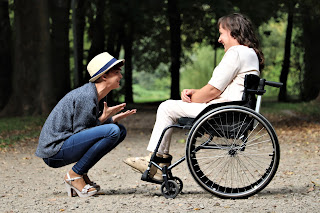Here in Minnesota, almost 17% of public school students receive special education services. This means that all youth development professionals will engage with youth with disabilities. For those new to disability work, this can provide some uncomfortableness that naturally comes with new experiences. It can be easy to make mistakes or not know exactly how to interact with someone who has a disability because we may feel that we need to interact with them differently than we would with others. Understanding disability etiquette can help everyone avoid some common mistakes and feel more comfortable. Basic disability etiquette involves treating people with disabilities with respect and making them feel valued.
Some basic disability etiquette tips include:
- Speak directly to the person rather than their companion, aide, caregiver or interpreter. Avoid talking about a person as if they weren’t there when they are present.
- Presume competence by asking before you help. Don’t automatically assume that someone with a disability needs help, but rather offer assistance when someone asks for it and ask how you can help before acting.
- Be sensitive about physical contact. People may depend on their arms for balance or they may consider their equipment part of their personal space.
- Don’t make assumptions. All people are the best judge of what they can or cannot do, so let them decide.
- Use person first language, unless someone tells you they prefer different language. Refer to the individual first, then to their disability, when it is relevant and appropriate. For example, say "person with a disability" rather than "disabled person".
- Avoid terms that might potentially have an unintentional negative connotation. These include words like the "R" word, "spastic", "special", or "abnormal".
- Don’t portray people with disabilities as courageous, brave, special, or superhuman. This implies that it is unusual for people with disabilities to have talents or skills.
- Avoid using the term "normal" for people without disabilities. It’s better to say "people without disabilities" or "typical".
In some instances, specific disabilities may have additional etiquette. For example, when interacting with people who are deaf or hard of hearing, remember to follow the person’s cues to determine how they prefer to communicate, speak clearly and distinctly in a normal tone, use gestures, make sure they can see you speaking, and speak directly to the person rather than to an interpreter. You can find additional disability-specific etiquette on the Minnesota 4-H Accessible for All Abilities Volunteer Resources Center’s Disability Etiquette Information Sheet.
When interacting with people with disabilities, first and foremost, be respectful and show that you value them for the unique individuals that they are. When you make a mistake, remember to sincerely apologize and try to do better next time.
When thinking about interactions you’ve had with someone with a disability, which of the shared disability etiquette tips did you mess up on or do really well with? Are there any other tips that you would share based on your own learning or life experiences?
-- Darcy Cole, Extension educator
You are welcome to comment on this blog post. We encourage civil discourse, including spirited disagreement. We will delete comments that contain profanity, pornography or hate speech--any remarks that attack or demean people because of their sex, race, ethnic group, etc.--as well as spam.

Great list! I did well with asking someone if it was okay to push them in their wheelchair, but then I couldn't figure out how to unlock the breaks! Thankfully, another person showed me what to do. I think other people saw that we don't have to do everything perfectly.
ReplyDeleteGreat example, Sarah! Consent and asking before helping is so important. As is modeling vulnerability, that we all make mistakes, and that we don't have to do everything perfectly even when we might be more experienced in supporting people with disabilities. It also demonstrates that we're all learning together and that we want to help and do our best. Thanks for sharing!
DeleteAs a parent of a couple of children with disabilities, one thing I have learned is they just want to be treated how you would treat others. Yes, they may have different abilities, but they are still wanting to be excepted like everyone else is.
ReplyDeleteThank you for the clear and informative post. I recently fell into the trap of portraying parents of youth with disabilities as superhuman. Parents are working really hard but marking their everyday as courageous and superhuman also creates and other category for them which is not helpful and feels disconnecting. The parents did not correct me but their general reaction was not positive and as I thought about it more I returned to apologize and we had a good conversation about this issue.
ReplyDelete